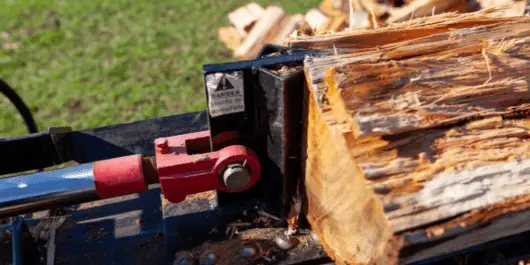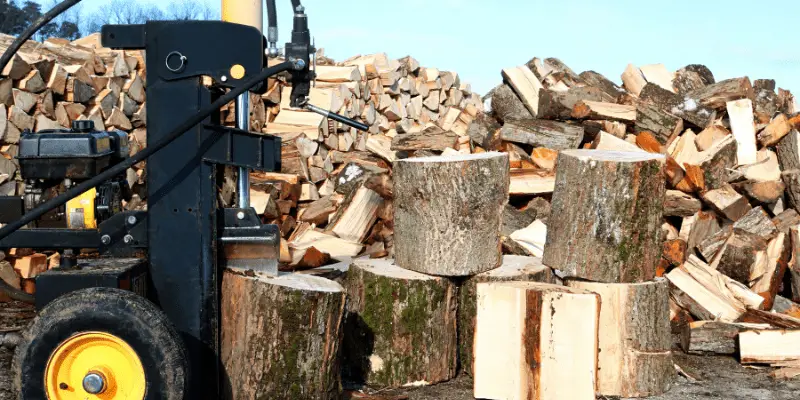Are you a log splitter user new to the world of log splitters, and you want to understand the concept of cycle time on log splitters? If so, then you are in the right place at the right time.
Cycle time on log splitter refers to the amount of time it takes for the ram to extend fully and split the logs and then return to its starting position. The cycle time is significant and a surprising number of people often overlook it. Whether you are a beginner or an expert log splitter user, the cycle time is something that you simply cannot overlook.
In this article, you will get to know all about the cycle time, what is cycle time on a log splitter, what affects the cycle time of a log splitter, how to improve the cycle time, potential downsides of using a fast log splitter, and more. Stick around to get all the answers that you are looking for.
What is cycle time on a log splitter?
Log splitters are complicated yet simple backyard machines that make your log-splitting work easier. The cycle time is one of the things that you’ll need to know about when you first start using log splitters. The cycle time of log splitters is essential and something that a surprising number of users overlook. Whether you are a newbie who is just getting into log splitters or a seasoned pro, you shouldn’t ignore the cycle time of your log splitter.
In simple terms, the cycle time of a log splitter is how much time it takes for the ram to fully extend, split the log, and return to its starting place. If a log splitter has specifications that say it has a cycle time of 13 seconds, then it means 13 seconds is how long it’ll take for the machine to split the wooden log. However, there are certain variables that can affect it, including how knotted the wooden log is and if the wood is softwood or hard.
It is a basic answer, sometimes so simple that it can feel a little overwhelming. However, with all things, the more that you try to look into it, the more complicated it can become. Learning the breakdown of log splitter cycle time and effects of the cycle time can be quite useful, and you’ll get to know all about it below.
What affects the cycle time of a log splitter?
There are numerous things that can affect the cycle time of a log splitter. The most significant factor is the GPM or Gallons Per Minute. GPM will determine how fast your log splitter is, and it is one of the main things that you must consider when looking for a new log splitter.
The hydraulic pump is responsible for pumping the hydraulic fluid, and it is a huge part of knowing what the GPM of your log splitter is. What type of hydraulic pump your log splitter has got will also play a key role in the cycle time.
Something that is often overlooked in log splitters and their cycle times is the type of cylinder it has. Having a smaller cylinder can increase the cycle time, but you’ll be sacrificing some splitting force.
When talking about splitting wooden logs and cycle times, there are a few things that affect the cycle time without being the log splitter’s fault. The type of wood you’re splitting, especially knotted wood and hardwood, takes longer to split and slows down the machine.
How to improve the cycle time of your log splitter
There are certain things that you can do when splitting logs that can speed up the cycle time of your log splitter. When splitting logs, the biggest issue can be the wasted movements of the ram with it having to go a few extra inches, wasting time. One of the simplest ways of speeding up your log splitter would be to stop the ram manually and then retract it.
Another thing that you can do would be to put something behind the wooden logs you are splitting. This way, the ram doesn’t actually need to travel as far as possible. Using another log would be a smart option as it is cheap and effective. Some people like making steel wedges to help with it, which is a wonderful option if you’ve got the capabilities.
As mentioned above, there are numerous ways to increase the speed of the log splitter. You can either upgrade your machine with better parts or simply adjust the way you’re using the log splitter. The latter will be the better option if you’re on a budget. Upgrading your log splitter can get expensive, and you’ll have to ask yourself if it would be better to just purchase a new log splitter. Sometimes, upgrading your old log splitter can spiral out of control financially.
When modifying or upgrading your log splitter, one of the first things to do would be to get a bigger hydraulic pump. A bigger hydraulic pump will increase the flow of the hydraulic fluid. For that to be effective in most cases, you will have to get a bigger engine, which can be quite expensive.
Once you have chosen a new pump and a new engine, you will have to look into getting larger supply lines. With a higher volume of fluid coming through, you will require something that can support that. Something that’s often overlooked is the cylinder of the log splitter and how its size affects cycle times. Using a smaller-sized cylinder with a large rod can increase the overall cycle time, but you will be able to lose out on hydraulic force, which is a decision you will have to make.
This can get quite expensive pretty quickly, and it will set you back up to $1200 or more. Then, there is also the need to have actual knowledge and skills to pull it off. Sometimes, getting a new log splitter will be the simpler and more logical choice.
Do you really need to use a fast log splitter?
This is something that comes down to your personal preferences and how much you enjoy splitting wooden logs. Sometimes, you might want to take your sweet time with splitting logs, as it can be a pretty enjoyable task. Meanwhile, at other times, you might wish to get it over with and do the task quickly.
Having a fast log splitter can be an issue, especially if you are splitting logs by yourself, as the splitter will be done before you’ve had the time to grab your next log. So, you have spent a fair share of money on the log splitter that is waiting on you, and it will feel like a bit of a waste.
If multiple people are splitting logs, then having a fast log splitter would be a better option. There will be far less downtime in this situation, and it’ll make getting a fast log splitter well worth your time. This is something that you will need to consider when you are buying a log splitter.
Some log splitter models may be slower, but they come with a higher splitting force. This is something you need to look into, as having more splitting force will be something that is considered more useful when splitting wood.
The potential downsides of having fast log cycle times
There aren’t many downsides to having a faster cycle time in your log splitter. However, there are mainly two things that come to mind. One of them isn’t much of a downside, but it is still something to consider before you get a new log splitter.
If you will be splitting wooden logs by yourself, then going for something extremely fast can be a bit of a waste. If your log splitter is splitting the logs quicker than you can handle, this means that you will have a lot of downtime for your log splitter.

The biggest downside of a fast log splitter is that they are usually more expensive. This is true for either buying a brand-new log splitter or upgrading one. It can end up hurting your wallet and make it something that isn’t financially worthy for some people and their small budget. If you can afford a fast log splitter and think you can handle the speed, then you should definitely go for it.
FAQs
How to calculate the tonnage needed for splitting logs
How much tonnage or splitting force your log splitter has will determine how much and what kind of wood you can split. To achieve that, you’ll first have to measure the piston’s diameter, then square it, and then multiply it by 3.14.
For instance, say that the diameter is 5 inches, you will have to multiply 25 by 3.14, which gives you 78.4. After that, divide it by 4. This will give you 19.625.
To obtain the splitting force, you must take this result and then multiply it with the log splitter’s pressure rating. This would give you a total splitting force of 58,875 pounds if the pressure rating is 3000 PSI. To obtain tonnage, you must divide the result by 2000, which will give you a tonnage of 29.437 tons.
What is the right log length for splitting?
The right log length for splitting will depend on your reason for splitting wood. If you are splitting firewood, then a 16-inch-long log would be ideal. This is the best possible log length for household fires. Thinner logs can burn out too quickly, whereas thicker logs take longer to dry out. For an outdoor fire, there isn’t any restriction as to what size of wood you can use.
What do you mean by cycle time?
The cycle time of a log splitter is the time the ram needs for fully extending splitting the wood and returning to its start position. If a log splitter has a cycle time of 11 seconds, then it means that the log splitter needs 11 seconds to split the log.
Which type of log splitter is the quickest?
There are many different types of log splitters, such as manual, kinetic, gas, hydraulic, and electric. Manual log splitters do not have a cycle time. The standard speed of a hydraulic log splitter is between 10 to 20 seconds. Meanwhile, the kinetic log splitter is the fastest and can split the logs within one second.


